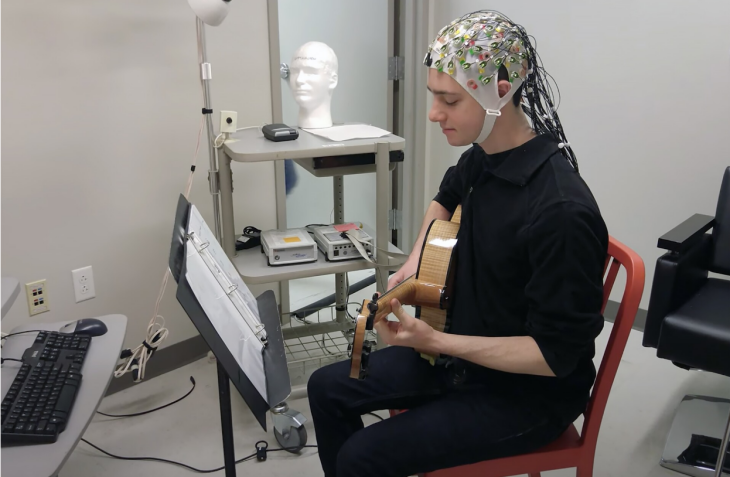
Flow, commonly called being in the zone, is where a person is totally engaged in performing an activity, up to the point where they are hardly self-conscious or conscious of their surroundings. What is flow from the perspective of brain functioning? One theory about it is that years of practicing a task causes the brain to develop a specialized network that produces specific ideas — for example, musical ideas — with little conscious effort.
1.Why does the author raise the question in Paragraph 1?
A To pursue an answer.
B To introduce the topic.
C To raise his puzzle.
D To share his interest.
解析:选B。B 推理判断题。作者在第一段中提出问题后,紧接着摆出了一个关于从大脑功能的角度来看心流状态的理论,并且在接下来的段落中描述了论证这个理论的相关实验和结论。由此可知,作者提出该问题是为了引出本文要讨论的话题。故选B。
2.What does Paragraph 2 mainly talk about?
A The result of the research.
B The function of EEGs.
C The way the research was conducted.
D The aspects the discovery can be applied to.
解析:选C。C 段落大意题。根据第二段大意,32名爵士吉他手在即兴演奏音乐时,研究人员对他们进行了与大脑功能相关的研究。即本段主要介绍了该项研究进行的方式。故选C。
3.What does John Kounios stress in his explanation in the last paragraph?
A Entering the flow state takes lots of practice.
B Not many supported the hypothesis of creative flow.
C Musicians benefit more from the findings.
D Charlie Parker often made mistakes in his performance.
解析:选A。A 推理判断题。根据最后一段中John Kounios所说的话“If you want to be able to stream ideas fluently, then keep working on those musical scales, physics problems or whatever else you want to do creatively”以及他引用爵士乐大师Charlie Parker的话“Then, you practice, practice, practice.”可知,他强调的是进入心流状态需要大量的练习。故选A。
4.What can be learned from the text?
A Flow happens when we’re not conscious.
B Musicians tell us how to stream ideas fluently.
C The mystery of brain functioning has been uncovered.
D We really are unconscious when we’re “in the zone”.
解析:选D。D 主旨大意题。结合第一段中的“One theory about it is that years of practicing a task causes the brain to develop a specialized network that produces specific ideas — for example, musical ideas — with little conscious effort.”有一种理论认为,多年来练习一项任务会使大脑形成一个专门的网络,产生特定的想法——例如,音乐的想法——几乎不需要有意识的努力;最后一段中的“Overall, the findings supported the ‘expertise-plus-release of control’ hypothesis (假说) of creative flow”总的来说,这些发现支持了创意心流状态的“专业知识+释放控制”假说。由此可知,当我们“进入心流状态”时,我们真的是无意识的。故选D。